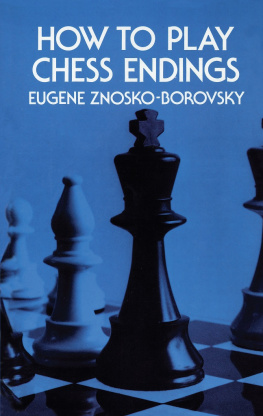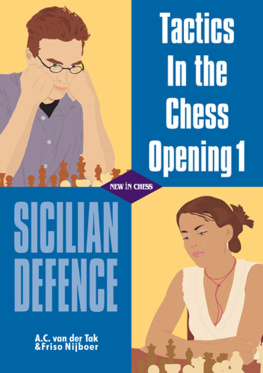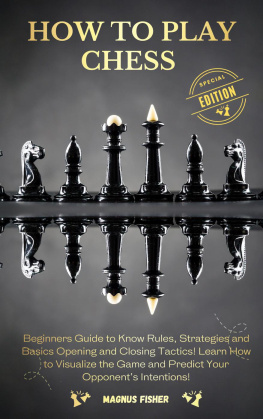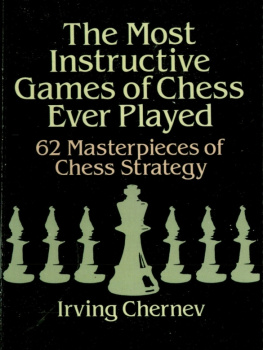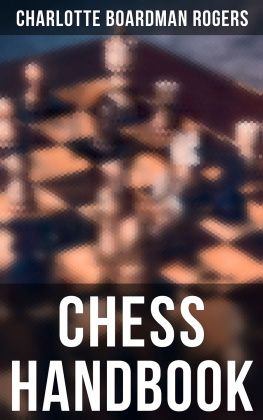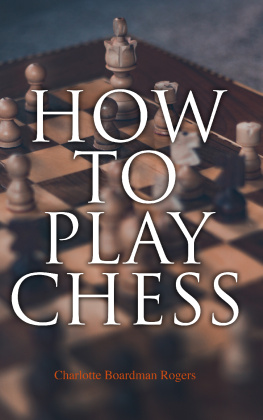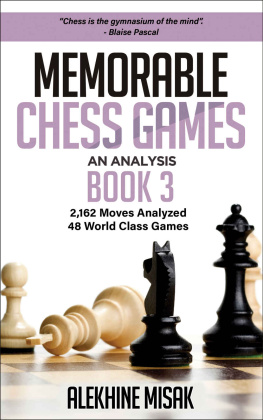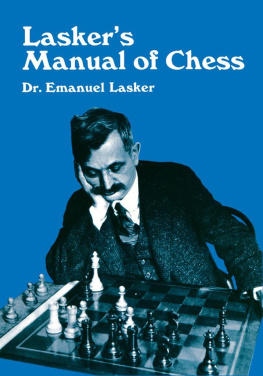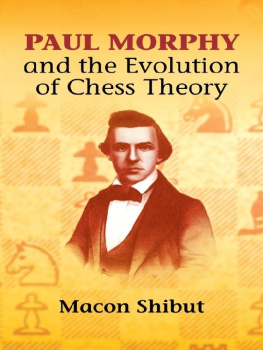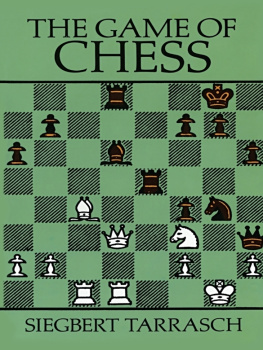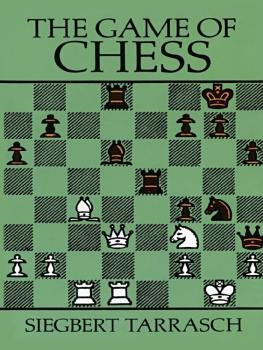HOW TO PLAY CHESS ENDINGS
Copyright 1974 by Dover Publications, Inc.
All rights reserved.
This Dover edition, first published in 1974, is an unabridged and corrected republication of the work first published in 1940 by the David McKay Company.
International Standard Book Number: 0-486-21170-3
Library of Congress Catalog Card Number: 74-82214
Manufactured in the United States by Courier Corporation
21170308
www.doverpublications.com
INDEX
.
TRANSLATORS PREFACE
The difference in playing strength between the master and the amateur is most marked, perhaps, in end game play.
The reason for this is twofold: games between amateurs do not reach the end game stage nearly so frequently as those of the masters, and then, chess literature has far fewer works to show on the end game than on the other stages, and the majority of these are not in English.
Several of the most famous of such books contain almost exclusively artificial, if artistic, studies and are of little practical and no pedagogical value.
Several modern works give greater prominence to positions from practical play and provide fine collections of examples of end game skill.
It was left to the pioneer spirit of Znosko-Borovsky to treat a notable subject in a notable manner. In How to Play Chess Endings we have a comprehensive text book in which the reader is taught the principles underlying end game play. Upon these principles an imposing edifice of logic is erected which covers the whole ground.
Memory plays little or no part in the development of end game skill if the precepts of this book are followed. It shows the way to logical but independent thinking.
Not the least achievement in the authors masterpiece, to my mind, is the fact that while showing that the end game is the most strictly logical and accountable part of a game of chess, he nevertheless discloses that it is capable of the utmost artistry, the most delightful and unexpected turns.
To have written such a thorough treatise on a difficult and reputedly arid subject in an entertaining and altogether fascinating manner is an achievement in chess literature.
J. DU M ONT .
INTRODUCTION
The main difficulty in the study of the end game is the apparent impossibility of setting up general principles for this phase of the struggle. Here all seems to be a question of arithmetic; it is the kingdom of cold calculation. At no other stage is each single move of such importance: it either wins or loses. Neutral, noncommittal moves are seldom available. Positions may appear similar, but each one, as a rule, has some special characteristic, which makes it an individual case: a pawn being advanced or not affects the result of the game; often the move decides.
In these conditions how could relatively stable principles be established? It is possible to tabulate types of positions leading automatically to some definite result and to learn them by heart. But would that really be chess, the game we love?
In addition, it seems that a number of fundamental principles, applicable at any other time, have no bearing on the end game: in fact their very opposite frequently obtains. One single pawn can win, where two Knights remain helpless; what can be said of the value of the centre, when a distant pawn on the wing wins against a centre pawn? The result depends perhaps on but one tempo.
On entering upon the end game stage, we must forget all we have learned; a new and different type of game begins. We pass from a game of chess, one is almost tempted to say, to a complicated species of draughts.
If we have failed in forethought, a very sudden change occurs at this precise moment, with, not seldom, a rude awakening.
With victory in sight, our fond dreams are shattered there is a depreciation in values and the ending proves to be unfavourable, possibly lost.
Our opponent may have been more far-seeing, but, at any rate, we have not taken the necessary precautions. An accident, perhaps, but we were not insured.
Once the end game is reached, it is too late to think out ways and means: there is nothing to be done but to deal with the situation as it is. But, if appropriate measures are taken in good time, there is nearly always some way of avoiding, or of delaying an end game, or at least of modifying its characteristics. If we realize that we shall be unfavourably placed in the forthcoming end game, we must try to eliminate weaknesses from our position. There are many ways of effecting this: we can conserve a piece which would make a win difficult for our opponent, or exchange a hostile piece which might become dangerous, and we must try to improve and consolidate our pawn formation.
To that end it is essential to have some knowledge of the main characteristics and requirements of end game play. We shall then realize that there are certain general principles applicable to this phase of the game. If we are conversant with them, they will guide us in our operations when we prepare for an ending before it actually occurs.
A good deal of theoretical learning thus becomes necessary and should be the object of concentrated study.
It is a pity when a well-contested game is utterly spoilt through the lack of knowledge of end game theory. And yet it is constantly happening. Instinct and inspiration can be trusted less in an end game than at any other stage of the game. Technique is all-important here, and is the deciding factor. Masters who give simultaneous performances know this very well. They frequently and deliberately bring about a perfectly even end game position, in the justified assumption that they will prevail, because their adversary is lacking in end game technique, even though he has conducted his game magnificently up to that point, and given free rein to his imagination. Imagination is of little value in an end game. There the artist must give way to the artisan, who is sure of his craft.
The student must therefore acquire this technique, see things as they are, without illusions. Once his mind can see clearly the why and wherefore of end game technique, he will be able to put his knowledge into practice. Then, if it is in him, he will be able to create exquisite works of art and to find surprising turns.
Those who are unable to play an end game can have no conception of the beauty which it contains, its subtlety, its finesse. It is the art of the jeweller, the art of the miniature. Middle game methods, at times, savour of the bludgeon, when compared with the filigree work of the ending. Often they seem coarse and disappointing by comparison.
I invite my readers, especially those who have studied my previous publications, to follow me on a fresh journey.
They must not expect to find here all there is to learn about the end game. Rather would I be their guide, telling them of essential facts, easy to comprehend and to retain, which will help them to find their way in a maze of complicated variations. They will learn to think correctly, to calculate rapidly without blundering, in short, to feel at home in the intriguing but delicious labyrinth, which is the end game.
After that it remains for the reader to take his chessboard and to become a practical end game player, and for the spectator to smile frequently and, at times, to admire.
T HE E LEMENTS
We shall now examine in what manner chess fundamentals affect the end game, how far-reaching is their influence there and to what extent their application varies as compared with the other phases of the game. It is assumed that, in a general way, the reader is familiar with the various elements. In any event, they are fully described in my book, The Middle Game in Chess, and popularized in How Not to Play Chess.

